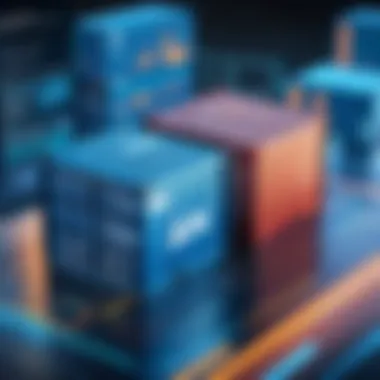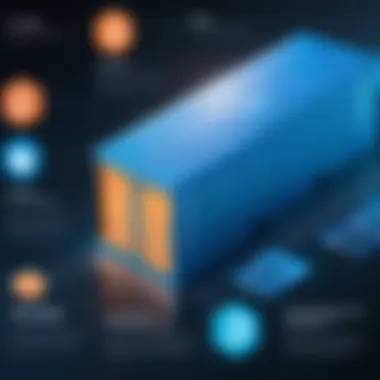Understanding Veracode Container Scanning for Security


Intro
In today’s digital landscape, the security of software applications is paramount. With the rise in containerization, ensuring the integrity of these containers is critical. Veracode's container scanning emerges as a significant tool in addressing security concerns related to containerized applications. This section introduces the essential aspects of Veracode container scanning, paving the way for a deeper understanding of its methodologies and advantages.
Key Features
Veracode container scanning offers various functionalities designed to enhance software security. The features of Veracode container scanning can be categorized into several key areas:
Overview of Features
- Comprehensive Vulnerability Scanning: This feature examines containers for security vulnerabilities, ensuring that potential threats are identified before deployment.
- Integration with CI/CD Pipelines: The tool is designed to work with existing Continuous Integration (CI) and Continuous Deployment (CD) processes, enabling seamless security checks throughout the software development lifecycle.
- Detailed Reporting: Veracode provides clear and detailed reports on identified vulnerabilities, allowing teams to prioritize remediation efforts effectively.
- Integration with Third-Party Tools: It can work in conjunction with popular DevOps tools, enhancing overall workflow without causing disruptions.
Unique Selling Points
While there are several container scanning solutions available, Veracode distinguishes itself with the following:
- Expertise in Application Security: Veracode has a long-standing reputation in the realm of application security, ensuring that its container scanning is part of a robust security strategy.
- User-friendly Interface: The platform is designed with usability in mind, making it accessible for both security experts and developers alike.
- Rapid Scanning Capabilities: Veracode’s technology allows for quick scans, minimizing potential delays in the development process.
Pricing Structure
Understanding the pricing structure of Veracode container scanning is crucial for businesses considering its implementation. The pricing is often tiered, allowing organizations to choose a plan that best fits their needs.
Tiered Pricing Plans
- Basic Plan: Designed for smaller teams, this plan provides essential scanning features at a lower cost.
- Advanced Plan: This tier includes more in-depth scanning options and advanced reporting features, catering to mid-sized businesses.
- Enterprise Plan: Tailored for large organizations, this plan includes full integration and support, along with custom features and services.
Features by Plan
- Basic Plan: Comprehensive vulnerability scanning and basic reporting.
- Advanced Plan: All features of the Basic Plan, plus CI/CD integration and advanced vulnerability analysis.
- Enterprise Plan: All features of the Advanced Plan, with prioritized support, customization options, and enhanced reporting capabilities.
By understanding these features and pricing options, organizations can make informed decisions regarding the adoption of Veracode container scanning, aligning it with their security goals and budget constraints.
Prelims to Veracode and Container Security
In today’s software development lifecycle, security is paramount. With the advent of containerization, developers have embraced a new paradigm that allows for agility and scalability. However, this transition also introduces a host of security concerns. Here, Veracode plays an essential role, bridging the gap between rapid deployment and secure practices.
Integration of Veracode into container security protocols reinforces the safety measures necessary to protect applications. The reliance on containers necessitates a strategy that ensures vulnerabilities are identified and mitigated before deployment. The importance of this solution cannot be overstated; without robust security measures, organizations expose themselves to significant risks.
The Rise of Containerization in Software Development
After the introduction of cloud computing, containerization emerged as a pivotal development in software engineering. Containers offer an efficient way to package applications, enabling seamless deployment across various environments. The light footprint of containers encourages developers to innovate faster while reducing overhead.
However, the popularity of containerization presents its challenges. As containers can bundle various dependencies, they may inadvertently introduce security flaws from third-party sources. The necessity for scanning these containers becomes evident. Implementing Veracode’s container scanning early in the development process allows developers to identify vulnerabilities related to both code and its dependencies. As a result, this approach contributes to a more secure development cycle.
Understanding Veracode’s Role in Secure Development
Veracode provides a sophisticated solution for identifying security weaknesses across an organization’s development landscape. Its methodologies combine automated scanning with manual reviews, ensuring a comprehensive assessment of containers. This dual approach fosters a culture of security among development teams.
Veracode is designed to integrate directly into existing CI/CD pipelines. This integration guarantees that security checks occur continuously, minimizing delays in development cycles. Continuous monitoring is essential, especially in environments that evolve rapidly due to updates and new features.
In addition to scanning capabilities, Veracode possesses robust reporting mechanisms. It translates complex security data into understandable insights for technical and non-technical stakeholders alike. Proper understanding and communication of data lead to educated decision-making across all levels of an organization.


Ultimately, as organizations pivot towards containerization, leveraging solutions like Veracode becomes critical. This proactive approach aids in not just identifying but managing vulnerabilities on an ongoing basis, fortifying the overall software security landscape.
The Importance of Container Scanning
Container scanning is a crucial element in maintaining the security and integrity of software applications. As organizations increasingly adopt container technology, the need for robust scanning mechanisms escalates. Effective container scanning serves not only to identify vulnerabilities but also to ensure compliance with regulatory standards and best practices. Addressing these aspects enhances overall security posture, reduces potential risks, and fosters trust among stakeholders.
Identifying Vulnerabilities Early
Early detection of vulnerabilities within container images is essential for several reasons. First, it enables development teams to remediate issues at the earliest stages of the software development lifecycle. The longer a vulnerability remains undiscovered, the higher the risk of exploitation, which can lead to data breaches and reputational damage.
Furthermore, scanning containers allows organizations to gain visibility into third-party dependencies and libraries used in their applications. A substantial percentage of vulnerabilities are found in these dependencies; thus, identifying them promptly can significantly minimize risk.
A few important strategies for early identification of vulnerabilities include:
- Regular Scanning: Implementing a routine scanning schedule ensures vulnerabilities are detected frequently.
- Automated Tools: Using advanced scanning tools like Veracode helps automate the detection process, making it efficient and less prone to human error.
- Integrating Scanning in CI/CD Pipelines: Incorporating vulnerabilities scanning into continuous integration and continuous deployment workflows allows teams to catch issues before they reach production.
"Finding a vulnerability early often costs significantly less than remediating one discovered later in the cycle."
Compliance and Regulatory Considerations
In today's complex regulatory environment, compliance is more critical than ever. Many sectors, including finance, healthcare, and data protection, have strict regulatory requirements governing software security. Container scanning plays a vital role in ensuring adherence to these standards.
Organizations must demonstrate that they proactively manage risks associated with their software components. Regular scans help to comply with frameworks such as PCI DSS, HIPAA, and GDPR by ensuring that applications do not harbor known vulnerabilities. Failure to meet these compliance requirements can result in severe penalties, fines, and loss of credibility.
Organizations can consider the following compliance-focused practices:
- Documentation of Findings: Maintain comprehensive records of scan results to demonstrate compliance during audits.
- Remediation Tracking: Develop a robust system for tracking the remediation of identified vulnerabilities to ensure timely fixes.
- Continuous Improvement: Regularly review and enhance scanning practices to align with evolving regulatory requirements.
In summary, container scanning significantly reduces security risks and facilitates compliance with essential regulations. Its role cannot be overstated as organizations navigate the challenges of modern software development.
How Veracode Container Scanning Works
Veracode Container Scanning is a vital component in modern software security practices. The method itself facilitates thorough examinations of container images, which is essential in today’s environment dominated by containerized applications. Understanding this process helps organizations establish a robust defense against potential vulnerabilities that can arise during the lifecycle of software development.
Analyzing Container Images
The core of Veracode Container Scanning lies in its ability to analyze container images. This involves inspecting the entire content of a container, including operating systems, libraries, frameworks, and application codes. By doing so, Veracode identifies outdated components or known vulnerabilities that could serve as entry points for malicious attacks.
When a container image is analyzed, it goes through various detection methods, including:
- Dependency Analysis: Scrutinizing all software dependencies within the container.
- Vulnerability Database Cross-Referencing: Checking against a live database of known vulnerabilities such as the National Vulnerability Database.
- Configuration Checks: Ensuring best practices in configuration to avoid misconfigurations that could lead to security risks.
This multi-faceted approach ensures that developers can address issues proactively. Running scans before deploying a container image minimizes risk and protects sensitive data from potential breaches.
Dynamic and Static Analysis Perspectives
In the realm of container security, both static and dynamic analysis methods play their roles.
Static Analysis examines container images in a non-executed state. This means that it inspects the code, dependencies, and configurations before they run. Static analysis is useful for discovering vulnerabilities at an early stage. Furthermore, it provides insights into the architecture and structure of the code, allowing developers to design and optimize their applications effectively.
On the other hand, Dynamic Analysis involves monitoring the behavior of a running container. This method observes real-time interactions between software components and the environment. It helps to:
- Identify runtime vulnerabilities that may not be evident during static analysis.
- Assess the effectiveness of security measures in place during actual execution.
- Monitor for any unusual behavior that could indicate a security incident.


Using both approaches in conjunction affords a comprehensive security posture for containerized applications. Not only can Veracode detect vulnerabilities early on, but it also provides deeper insights into the overall security health of the running application.
To ensure optimal security, organizations should integrate both static and dynamic analyses into their scanning protocols.
Overall, understanding how Veracode Container Scanning works equips organizations with the necessary tools to maintain and enhance their application security throughout the development lifecycle.
Key Features of Veracode Container Scanning
Veracode Container Scanning provides essential tools and features that are critical to organizations committed to maintaining high standards of security in their software development processes. This section discusses these key features, emphasizing their importance in ensuring secure containerized applications.
Comprehensive Vulnerability Scanning
One of the central components of Veracode Container Scanning is its comprehensive vulnerability scanning capability. This feature systematically evaluates container images, identifying potential security flaws before they are deployed. The scanning process encompasses known vulnerabilities, misconfigurations, and code quality issues. By mapping these vulnerabilities to established databases like the Common Vulnerabilities and Exposures (CVE), organizations can accurately assess risks associated with each component within their containers.
The advantage of such thorough scanning is the ability to address vulnerabilities early in the development cycle. Early detection reduces the cost and effort required to patch issues after deployment. Furthermore, with the complexity of modern software stacks, manual auditing becomes increasingly impractical. Therefore, automated scanning enhances efficiency and effectiveness, leading to a more secure development landscape.
Integration with / Pipelines
Integrating Veracode Container Scanning into Continuous Integration/Continuous Deployment (CI/CD) pipelines is another vital feature. This integration allows for real-time scanning of container images during the build and deployment processes. By embedding security checks into CI/CD workflows, organizations ensure that security practices are not an afterthought but a core part of their development lifecycle.
The benefits of this integration are manifold. First, it promotes DevSecOps practices where security is a shared responsibility across development, security, and operations teams. Second, it enhances speed and agility, allowing developers to receive immediate feedback on vulnerabilities, thus reducing the feedback loop. Lastly, seamless integration minimizes disruptions, enabling teams to maintain momentum while still prioritizing security.
User-Friendly Reporting Mechanisms
Lastly, Veracode offers user-friendly reporting mechanisms that facilitate easy interpretation of scan results. These reports present vulnerability findings in a clear and concise manner, with actionable insights provided for remediation. Users can easily navigate through various components analyzed, understanding their security posture at a glance.
Effective reporting goes beyond just stating there are issues; it prioritizes vulnerabilities based on severity, provides context, and suggests fixes. This clarity empowers development teams to focus on the most pressing threats first, creating a more structured approach to security management.
"In practice, user-friendly reports can significantly influence how security teams and developers engage with scanning results, ultimately shaping the security culture of an organization."
By harnessing these features of Veracode Container Scanning, organizations position themselves to create a robust security strategy that aligns with modern software development practices.
Benefits of Implementing Veracode Container Scanning
The implementation of Veracode container scanning is critical for modern development practices. With software applications increasingly relying on containers, the need for robust security measures is paramount. Veracode offers solutions that help organizations secure their containerized applications. The benefits are multifaceted, enhancing both security and operational efficiency.
Enhanced Security Posture
Organizations prioritize security to protect sensitive data and maintain user trust. By integrating Veracode container scanning, companies can significantly strengthen their security posture. This software enables developers to identify vulnerabilities in their container images before deployment. Early detection of these vulnerabilities minimizes the risk of exploitation.
With Veracode, security teams can monitor and analyze container images efficiently. They can ensure that the images used in production meet compliance standards. This monitoring is essential for maintaining the integrity of applications in dynamic environments. Furthermore, the automated nature of scanning reduces the chances of human error, making it easier to maintain high security standards.
"In today's rapidly evolving tech landscape, the safety of your software is as crucial as its functionality."
Cost Optimization through Risk Mitigation
Reducing costs while maintaining security is a top priority for many organizations. Implementing Veracode can lead to significant cost savings. By proactively identifying vulnerabilities, businesses can avoid costly remediation efforts post-deployment. Fixing security issues after a product is live can be financially draining and harm reputation.
Moreover, Veracode helps in meeting various compliance and regulatory requirements. Non-compliance can lead to hefty fines and diminishing customer trust. Thus, the financial investment in container scanning can prove beneficial by avoiding potential penalties.
The overall risk mitigation allows organizations to allocate resources more efficiently. Less time spent on resolving security incidents leads to better productivity. This optimization is not merely about saving costs but about fostering a secure environment conducive to innovation and growth.
Challenges in Container Scanning


Container scanning is a critical component of maintaining software security. However, several challenges can impede the effectiveness of these scanning efforts. Identifying these challenges is essential for IT professionals and business owners alike. Understanding the specific elements at play enables organizations to develop strategies that enhance their security posture.
One notable challenge in container scanning revolves around false positives. These occur when a scanning tool flags a vulnerability that does not actually exist. While the intent may be to ensure a robust security framework, the presence of false positives can lead to wasted resources and efforts. Teams may expend considerable time and energy addressing non-issues instead of focusing on genuine risks. Additionally, an overwhelming number of false positives can result in security fatigue among personnel. This fatigue can erode the effectiveness of security protocols since significant alerts may be ignored amidst the noise of false warnings.
Another pressing issue is the integration hurdles with legacy systems. Many organizations operate using older systems that may not easily accommodate modern container scanning solutions. The disparities between traditional infrastructure and new technologies can lead to compatibility problems. As security teams work to ensure compliance and effective monitoring, the inability to seamlessly integrate scanning tools can create gaps in protection. Such obstacles can hinder the team's ability to carry out necessary updates and adjustments in response to scanning results, leaving vulnerabilities exposed.
The consequence of these challenges is far-reaching. It impacts not only the security landscape of organizations but also their compliance with industry regulations. Therefore, it is vital for businesses to approach container scanning with a clear understanding of these challenges, ensuring they implement solutions that effectively address both false positives and integration issues. By doing so, they can safeguard their applications more effectively.
Best Practices for Effective Container Scanning
Effective container scanning is essential for maintaining security in modern software development. Following best practices enhances the overall security posture of applications, supports compliance, and mitigates risks associated with vulnerabilities. In this section, we dive deep into the strategies and methodologies that can lead to a successful container scanning implementation, ensuring organizations can protect their software environments.
Establishing a Scanning Protocol
The first step towards an effective container scanning practice is to establish a thorough scanning protocol. A well-defined protocol provides a clear framework for how, when, and where scans will be performed within the development lifecycle. Organizations should consider the following elements when creating their scanning protocols:
- Define Scan Frequency: Determine how often scans should occur. Regular scans are vital for spotting vulnerabilities early and should align with development updates.
- Specify Scanning Tools: Clearly identify which scanning tools will be used, such as Veracode's container scanning capabilities. This simplifies training and ensures consistency.
- Set Access Controls: Ensure that only authorized personnel can initiate or view scanning results, which protects sensitive information and maintains integrity.
- Integrate with CI/CD Pipelines: Integrate scanning into Continuous Integration and Continuous Deployment processes. This automation ensures vulnerabilities are identified before deployment, reducing the risks associated with moving to production.
By adhering to these criteria, organizations can systematically address vulnerabilities, ensuring containers are regularly scanned for security issues before reaching the end-user.
Continuous Monitoring and Improvement
Once a scanning protocol is in place, continuous monitoring and improvement are crucial for maintaining security over time. The landscape of vulnerabilities is always evolving, and organizations must remain vigilant. Here are some important considerations:
- Regularly Update Scanning Tools: Keeping tools up to date ensures that you are protected against the latest vulnerabilities. Vendors frequently release updates to address new threats.
- Analyze Scan Results: Establish a routine to analyze scan results critically. Look for patterns and recurring issues that might indicate deeper problems within the software development lifecycle or coding practices.
- Adapt and Enhance Protocols: Based on analysis, regularly enhance your scanning protocols to address identified shortcomings or newly surfaced threats. If a particular vulnerability is noted repeatedly, it may warrant more frequent scanning or additional development practices.
- Train Staff: Continuous education for IT and development staff on the latest security threats and scanning practices is essential. Knowledge sharing fosters an environment where everyone understands the importance of security.
Continuous improvement is not a one-time task. It requires persistent effort and commitment at all organizational levels.
By focusing on continuous monitoring and adapting practices, organizations maintain an agile response to the dynamic threat landscape, helping to ensure the security of their containerized applications.
Evaluating Alternatives to Veracode
In the realm of software security, evaluating alternatives to Veracode container scanning is crucial. Organizations must understand the variety of tools available and the unique benefits each brings. This promotes informed decision-making regarding security measures. Veracode excels in many areas, but exploring other options could lead to a more tailored solution for specific needs.
Benefits of Evaluating Alternatives
- Broader Knowledge: Gaining insight into various tools provides context on security features, functionalities, and integration capabilities.
- Customization: Not every organization has the same requirements. Different tools allow for strategies that fit particular workflows and company structures.
- Cost Efficiency: Some alternatives may offer more competitive pricing without compromising on essential features.
- Innovation: Technology progresses quickly. New entrants in the market can provide advanced features and enhancements that established solutions may lack.
When exploring these alternatives, organizations should consider factors like compatibility with existing systems, the depth of vulnerability coverage, and the user experience. Understanding these elements ensures a long-term security strategy is more robust and adaptable.
Culmination: The Future of Container Security
The landscape of container security is reshaping continuously. As organizations embrace modern application development practices, the importance of effective container scanning becomes more pronounced. In this section, we will explore the various trends shaping the future of container security, and summarize vital considerations for effective implementation.
Trends Impacting Container Scanning Technologies
Several trends are currently influencing container scanning technologies. Some notable ones include:
- Increased Adoption of DevSecOps: As security becomes ingrained in the development process, tools like Veracode must adapt to fit seamlessly into DevSecOps practices.
- Machine Learning and AI Integration: Emerging technologies such as machine learning are being integrated into container scanning solutions. These technologies help in identifying patterns in vulnerabilities, improving accuracy in detection.
- Shift towards Cloud-Native Applications: As organizations migrate to cloud-native architectures, there is increased pressure for container security solutions to evolve. This shift requires tools to offer comprehensive support across different cloud providers.
- Regulatory Compliance Enhancements: New regulations mandate stricter security protocols. This impacts how container scanning tools must be designed to ensure compliance.
"The future of container security lies in its ability to adapt to the rapid changes in technology and threat landscapes."
Staying ahead of these trends can help organizations safeguard their applications effectively. Companies must invest in technologies that not only address current vulnerabilities but also anticipate future threats.
Final Thoughts on Implementation
Implementing Veracode container scanning is a strategic decision that safeguards software development. It entails several key considerations:
- Assessing Organizational Needs: Before implementation, organizations should evaluate their specific security requirements. This includes understanding their development environments and existing security measures.
- Training and Awareness: Educating staff about container security is crucial. Awareness about best practices and security protocols aids in reducing vulnerabilities from human factors.
- Regular Updates and Maintenance: As threats evolve, so should the tools. Regular updates ensure the scanning solutions remain effective against new vulnerabilities.
- Feedback Loops: Establish mechanisms to gather feedback from the users of container scanning technologies. This fosters a culture of continuous improvement.















